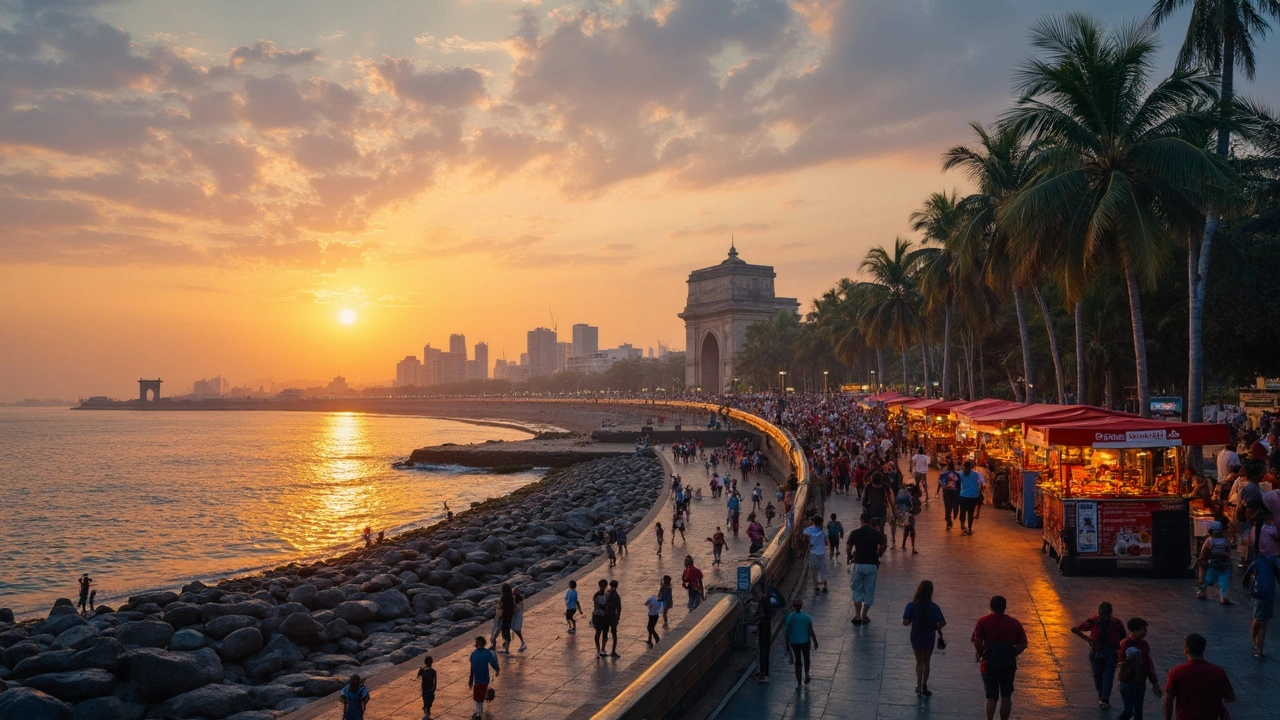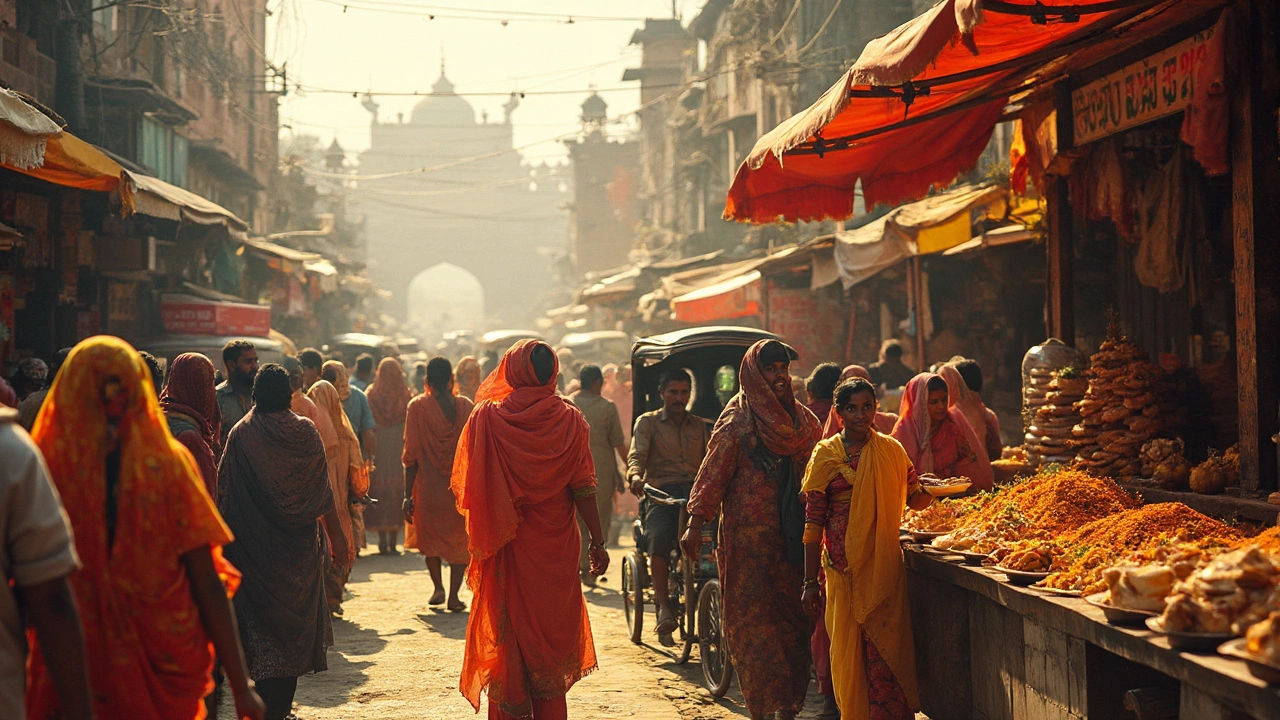Ask two people in India which is more beautiful, Delhi or Mumbai, and you’ll get two very different answers—probably louder than you expect. Even if you’ve never been, you’ve seen the headlines: Delhi’s grand history and winter fog, Mumbai’s endless energy and coastline. But beauty means different things to everyone. Are you after stunning buildings, food memories, epic street photos, or something else entirely?
The truth is, both cities are a mix of chaos and charm. Delhi lures with old forts, lush gardens, and winter mornings that seem out of a storybook—until you run into traffic or that famous smog. Mumbai, meanwhile, has that humid sea breeze, colonial buildings, nonstop street life, and sunsets over the Arabian Sea. Figuring out which city suits you better isn't just about looks—it’s about what you want to experience, right down to what breakfast smells like on a street corner and how late the city keeps singing at night.
- First Impressions: Atmosphere and Vibes
- Iconic Sights and Hidden Corners
- Food, Nightlife, and Local Life
- Tips for Travelers: Which City Wins?
First Impressions: Atmosphere and Vibes
Step off the plane in Delhi, and you’re hit by a blend of Mughal history and day-to-day hustle. The city feels serious—government buildings on Rajpath, old houses in Chandni Chowk, and leafy neighborhoods like Lodhi Road. Early mornings in winter? Locals head to India Gate bundled in shawls, with that fog so thick, even car headlights look weak.
Contrast that with Mumbai, where the first thing most people notice is the sticky air. The city feels lighter, quicker—rickshaws zip by, people spill out of local trains, and the skyline bumps into palm trees and the Arabian Sea. On Marine Drive, crowds gather to watch the sun dip behind the Haji Ali Dargah. There’s a sense of things moving nonstop. Bollywood posters glitter next to old Irani cafes and glassy new towers.
"Mumbai is a fast-paced dream, but Delhi’s stories make you linger," says journalist Vir Sanghvi, known for his travel columns about both cities.
It’s not just vibes—look at the numbers. Delhi has a population of around 33 million, but Mumbai fits over 21 million into a much smaller area. That means Delhi offers more green pockets, and traffic jams that go on forever. Mumbai feels more crowded, but the sea breeze helps keep it feeling fresh.
| City | Population (2025 est.) | Main Attraction | Popular Season |
|---|---|---|---|
| Delhi | 33 million | Red Fort, India Gate | Oct-Mar (Winter) |
| Mumbai | 21 million | Gateway of India, Marine Drive | Nov-Feb (Cool, dry) |
Here’s what stands out right away:
- Delhi’s mix of old and new feels more dramatic—ruins stand next to glass offices.
- Mumbai seems more relaxed about its past, focusing on business and nightlife.
- If you like space and history, Delhi hits different. If you like movement and ocean air, Mumbai’s your place.
Honestly, first impressions come down to what you notice—the smell of street food, the honk of rickshaws, or the shape of the skyline. Both cities have energy. It just hits you in totally different ways.
Iconic Sights and Hidden Corners
If you’re serious about seeing the real personality of Delhi, you’ve got to visit the Red Fort. There’s nothing quite like walking through its massive red sandstone gates and realizing—they actually built this back in the 1600s, no modern tools, no shortcuts. Humayun’s Tomb gives you a taste of what inspired the Taj Mahal, and it’s way less crowded. Flip over to India Gate for a people-watching session or a lazy picnic on the lawns. Lodhi Garden is another gem—a peaceful, green pocket bursting with old tombs and joggers dodging stray dogs.
But Delhi’s greatness hides in the little spots too. Chandni Chowk is chaotic and kind of overwhelming, but it’s the gold standard for street eats, bargain shopping, and finding corners that somehow escaped the bulldozers. Ever heard of Hauz Khas Village? It’s full of tech start-ups, hipster bars, and a medieval water tank, all smashed together. Head there for a different vibe altogether.
Now, Mumbai is much more about the rush to the sea. Gateway of India is where you’ll see everything from newlyweds getting their photo taken to serious tourists waiting for a boat to Elephanta Caves. Colaba’s old buildings and tiny cafes are perfect if you like wandering and getting lost. Don’t forget Marine Drive—you’ll see locals just hanging on the promenade, especially at sunset, which is hands down one of the prettiest city scenes in the country.
If you’re tired of the big names, duck into the lanes of Bandra. This area explodes with street art and tiny bakeries. Banganga Tank? It’s a 12th-century holy water tank hidden in the chaos of Malabar Hill. Most tourists miss it, but locals say it’s pure magic. For beaches, Juhu and Versova are good for a chill evening, maybe some Mumbai-style bhel puri right on the sand. You’ll never run out of photo ops.

Food, Nightlife, and Local Life
Food is a massive deal in both Delhi and Mumbai, but they play the game differently. Delhi is famous for its rich, spice-heavy North Indian menu—think butter chicken, chole bhature, and parathas from local stalls in Chandni Chowk. In fact, the paratha sellers in Old Delhi have been around for over a century. You can eat like royalty here for the price of a soft drink back home.
Mumbai, on the other hand, keeps things lighter and zippier. Legendary street foods like vada pav, pav bhaji, and bhel puri make the city tick. The classic hot samosas at Kyani & Co. or midnight ice cream on Marine Drive are standard for locals. Plus, coastal vibes mean fresh seafood—Bombay duck fry at Gajalee is a crowd favorite. If you want to grab a late-night bite, Mumbai wins with options running 24/7, especially in places like Juhu and Bandra.
Nightlife scenes? Both cities stay up late, just in their own styles. Delhi nightlife has exploded in the last ten years—Hauz Khas Village, Cyber Hub, and Connaught Place are hotspots with everything from microbreweries to loud bars. Popular clubs like Social and Kitty Su attract all sorts, while rooftop lounges let you chill after a long day of sightseeing.
Mumbai does nightlife more naturally. As India’s entertainment capital, you never know when you’ll spot a film star at places like Olive Bar or Toto’s Garage. Colaba Causeway and Lower Parel buzz until morning. Alcohol service ends later in Mumbai compared to Delhi, and there’s a stronger live music and club scene overall. If you want to walk out and hear music pouring onto the street, Mumbai is your city.
For real local life, Delhi can feel a bit traditional; whole neighborhoods run by community, like Lajpat Nagar (famous for its market scene), while Dilli Haat is a great intro to pan-Indian crafts and snacks. Mumbai is always on fast-forward but blends people from across the country, so there’s an easygoing, you-belong-here vibe. The local train is insane—over 7.5 million people ride it every day—which is basically the city’s beating heart. Hop on if you’re up for an adventure, just try not to get caught in rush hour.
| City | Signature Street Foods | Main Nightlife Area | Unique Local Experience |
|---|---|---|---|
| Delhi | Chole Bhature, Butter Chicken, Parathas | Hauz Khas Village, Connaught Place | Old Delhi bazaars, Dilli Haat, food walks |
| Mumbai | Vada Pav, Pav Bhaji, Bhel Puri | Colaba, Bandra, Lower Parel | Marine Drive at sunset, local trains, Bollywood vibes |
Tip: If you’re picky with food, Mumbai is usually easier on the stomach, thanks to its lighter coastal cuisine. For foodies who love spice and don’t mind heat, Delhi’s street food scene is a must-try. And if you love to party, just know Mumbai stretches the nights longer and stronger.
Tips for Travelers: Which City Wins?
Forget the pictures you’ve seen on Instagram for a second—your real experience in Delhi or Mumbai will depend on how you like to travel. Plan it your style, and both cities will deliver, but here’s how to tip the scales in your favor.
- For history buffs: Delhi wins, hands down. You’ll find UNESCO spots like Humayun’s Tomb, Red Fort, and Qutub Minar right in the heart of the city. Don’t miss Chandni Chowk for old-school markets and street eats. City guides always say, "Delhi is like a living museum." It’s true.
- For beach lovers: Mumbai comes through—no question. Chowpatty and Juhu beaches aren’t exactly postcard-perfect, but sitting with locals at sunset, eating spicy bhel puri, makes up for it. And Marine Drive at night? Can’t beat the vibe.
- Best for foodies: Both have insane food scenes, but they’re totally different. Delhi equals rich Mughlai feasts and street food like chole bhature, golgappas, and parathas. Mumbai is about quick bites: vada pav, pav bhaji, and kebabs by the sea. If you like fusion or experimental cafés, Mumbai has a slight edge.
- Party animals: Mumbai stays up later. The nightlife here is famous—rooftop bars in Bandra, live music at Colaba, or just midnight drives with ice cream. Delhi’s scene is growing, but it still closes down earlier and feels more spread out.
- Getting around: Delhi Metro is efficient and super cheap (and it’s got a women-only carriage). But traffic can be brutal. Mumbai locals swear by their local trains, which run like clockwork but get jam-packed at peak times. Apps like Uber, Ola, and Auto rickshaws work well in both cities.
The best advice? Travel with an open mind and some patience. Pollution is a reality in both cities, but Delhi’s winters mean air quality can drop fast. Mumbai’s monsoons (June–September) bring floods but also dramatic city life. Pack with the season in mind.
A Lonely Planet review puts it straight:
"No Indian city is more breathtaking than Mumbai at sunset, or more haunting than Delhi at dawn."Pick the city that fits your mood. Either way, you’re going to leave with a hundred stories—and cravings that’ll bring you back.
